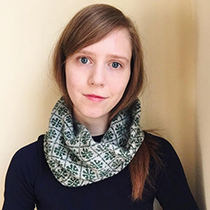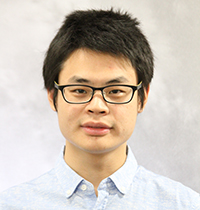This prize recognizes the superior research achievements of doctoral students. These graduates covered a breadth of topics from nineteenth-century asylum life and sickle cell research to the influence of Roman poetry in colonial Latin America and neurons that act as metronomes to keep time in the brain.
 Madeline Bourque Kearin ’20 Ph.D.
Madeline Bourque Kearin ’20 Ph.D.
Madeline is recognized for her dissertation in Anthropology, “A Refuge of Cure or of Care”: The Sensory Dimension of Confinement at the Worcester State Hospital for the Insane.
Her research focuses on how nineteenth-century institutions, originally thought to be ideals of therapeutic health, turned into dilapidated homes with forgotten and neglected patients. She approached her topic through a sensory perspective.
“Rather than a recapitulating an account of institutional decline, her study of the senses empowers a rich exposition of the events and rhythms of asylum life according to the experiences of administrators, doctors, patients, and visitors,” says Robert Preucel, Professor of Anthropology and Director of the Haffenreffer Museum of Anthropology.
Kearin’s research was drawn from historical archaeology and architectural studies and involves a close reading of administrative documents, newspaper articles, diaries of patients, and historic photographs.
Her “dissertation is a superb piece of scholarship that showcases anthropological historical archaeology’s ability to combine conceptual and methodological synergies to shed light on important issues in the past that are no less relevant today. Here the issue is mental health and how it was treated in the nineteenth century and its legacy for the current mental crisis,” says Patricia Rubertone, Professor of Anthropology and Director of Graduate Studies, and Kearin’s dissertation advisor.
Kearin’s research has been recognized by a number of major institutions, including the American Antiquarian Society, the Massachusetts Historical Society, and the Countway Library of Medicine at Harvard University. She was also awarded a graduate fellowship at the John Hay Library.
Kearin has been active in sharing her results with the professional community. She presented at several conferences while working to complete her dissertation. She has been approached by several publishers about the possibility of turning her dissertation into a book and submitted to one publisher for consideration.
Additionally, sections of her dissertation have been published as articles in History of Psychiatry, Journal of Medical Humanities, and New England Quarterly. She has also been published in The Public Historian, The Historian, Journal of the History of Medicine and Allied Sciences, and Markers: The Annual Journal of the Association for Gravestone Studies.
“Working on a Ph.D. over many years doesn't provide a lot of instant gratification; it’s a slow and laborious process that requires a lot of self-motivation. It’s gratifying to receive outward recognition,” says Kearin.
Kearin is currently working as the Library Assistant at the Worcester Historical Museum where she began in January of this year. She handles collections management, answers research requests, and assists patrons in using the library’s resources. Since mid-March, when the museum closed due to COVID-19, she has been working on building digital exhibits and resource guides for the museum’s website.
Lu Lu '20 Ph.D.
 Lu is graduating with a doctorate in Applied Mathematics and has already earned a master’s in Engineering and Applied Mathematics from Brown. Through the Open Graduate Education program he additionally completed a master’s in Computer Science last year. His dissertation is entitled, Theory, Algorithms, and Software for Physics-Informed Deep Learning.
Lu is graduating with a doctorate in Applied Mathematics and has already earned a master’s in Engineering and Applied Mathematics from Brown. Through the Open Graduate Education program he additionally completed a master’s in Computer Science last year. His dissertation is entitled, Theory, Algorithms, and Software for Physics-Informed Deep Learning.
Lu’s research interests combine applied mathematics, physics, computational biology, and computer science. He credits the Open Graduate Education program for providing him the opportunity and support to pursue a third master’s degree. “The knowledge in Computer Science enables me to write this dissertation,” he says.
He specializes in two fields: modeling biophysical systems and machine learning. “Although these two fields require different knowledge and techniques, he has done an equally excellent job and he is an expert on both fields,” says George Em Karniadakis, Professor of Applied Mathematics.
Lu studies modeling biophysical systems at the molecular and mesoscopic levels. As part of a sickle cell disease project funded by NIH, Lu developed two sickle hemoglobin (HbS) fiber models at different resolution levels. These fiber models provide a unique opportunity to replicate the multi-scale process of HbS nucleation and can then be used to test the efficacy of drugs to treat sickle cell disease.
“Lu’s work has pushed the frontiers of biophysics modeling by developing the most detailed and scalable simulator of red cells at protein resolution,” says Paris Perdikaris, Assistant Professor in Mechanical Engineering and Applied Mathematics at the University of Pennsylvania who worked with Lu at Brown.
In both fields, Lu has published close to 20 original papers on diverse topics of modern scientific computing, machine learning, and computational biology. He has developed an open source software library for deep learning that has been downloaded nearly 20,000 times. Several of his papers were featured on the cover and the website of notable journals and other media outlets.
Additionally, one chapter of Lu’s dissertation has already been published in the Proceedings of the National Academy of Sciences and the other four chapters have been submitted and are currently under review.
With a strong background in Computer Science, Lu developed two very popular software packages: OpenRBC and DeepXDE. OpenRBC is a molecular dynamics simulator, which is capable of simulating an entire red blood cell with explicit representation of lipid bilayer and cytoskeleton by multiple millions of atomistic particles. He won an IBM OpenPOWER Developer Challenge prize for this computational code and it was published as computational tools in Biophysical Journal. He also developed DeepXDE, a deep learning Python library for solving almost all types of differential equations.
“A closer look into Lu’s research reveals his remarkable technical depth, but also a wide range of interests. By bringing together a strong background in biophysics, statistical learning, and high-performance computing, his work is exemplary in bridging theory, experiments, and large-scale computations,” says Perdikaris.
“I have had a very fulfilling life in the past six years at Brown. My interdisciplinary education background lying at the ‘triple point’ of Applied Mathematics, Computer Science, and Engineering enables me to write this dissertation and forge my career pathway,” says Lu.
Lu has accepted an Applied Mathematics Instructor position at MIT Department of Mathematics and will begin next fall.
 Erika Valdivieso ’20 Ph.D.
Erika Valdivieso ’20 Ph.D.
Erika is recognized for her Classics dissertation, Virgilian Imitation in Colonial Latin America.
Her dissertation offers the first paradigmatic study of Latin poetry written in colonial Latin America in the style of the ancient Roman poet Virgil. Valdivieso proposes that these texts do not constitute a new species of the Virgilian tradition but rather show how complex and diverse that tradition is: Virgil belongs as much to Latin America as to any other part of the world. These text, in turn, are important for those interested in the classical legacy as well as in the development of Latin American literature.
“By thoughtfully and methodically tracing this influence in a set of hitherto understudied or even unstudied poems, Erika’s work opens up a large and diverse body of texts for use by scholars of early modern Europe and its colonial enterprises and of the literature of the sixteenth through eighteenth centuries,” says Joseph D. Reed, Brown Professor of Classics and Comparative Literature.
Valdivieso’s nominators concur that her research is at the cutting edge of an emergent subfield and praise her unique knowledge of Greek and Roman literature.
“She is singularly equipped to pursue such cross-disciplinary research which takes the history of scholarship and the classical tradition into new multicultural and social historical domains,” says Andrew Laird, advisor, the John Rowe Workman Professor of Classics and Director of the Center for the Study of the Early Modern World.
Valdivieso’s work is another example of the ability for Brown scholars to cross programmatic boundaries and expand their reach. She took advantage of the resources of Brown’s Hispanic Studies department, with its expertise in early modern Spanish literature, as well completed a fellowship at the John Carter Brown Library. Additionally she sought funding from various other sources, including the Global Mobility Research Fellowship, to support her travel and research in international locations.
“This was not the way I imagined ending my time at Brown, but receiving this award is a reminder that the community in which I studied and taught is not bound by the physical space of the campus," she says.
Valdivieso was a Presidential Scholar at Brown and holds an MAT in Latin from the University of Michigan.
Hyeyoung Shin ’20 Ph.D.
 Hyeyoung is honored for her Neuroscience dissertation, Putative Timekeeper Neurons and Noncanonical Brain Rhythms in Perception.
Hyeyoung is honored for her Neuroscience dissertation, Putative Timekeeper Neurons and Noncanonical Brain Rhythms in Perception.
Her research addresses two fundamental questions on the mechanisms and meaning of brain rhythms in sensory perception. Brain rhythms are among the most prominent signatures of brain function, especially in identifying healthy brain activity.
Shin examined brain activity at 40Hz gamma and 20Hz beta rhythms. In the 40Hz gamma band she identified a new class of inhibitory neurons that can serve as a rhythmic clock to synchronize and gate the flow of sensory information to induce perception. At the lower frequency of 20Hz beta rhythms she developed new computational methods to examine features that influence tactile detection. She applied these methods to both human and mouse data and found remarkably homology in their neural dynamics.
“In her thesis, Hyeyoung made a deep, potentially field-changing finding that may be a/the secret to the control of timing in the brain. Her finding may have solved a truly fundamental gap in our knowledge of brain function, a discovery she made by gathering biologically specific data and linking it to computationally deep principles,” says Christopher Moore, Professor of Neuroscience and Associate Director at the Carney Institute for Brain Research.
As Shin describes it, she discovered a distinct class of neurons that act as metronomes, keeping time in the brain. Despite being in the primary sensory cortex, these neurons did not respond to external sensory stimuli. Rather, their primary function appeared to be to orchestrate other neurons that do carry sensory information, such that those sensory responsive neurons could synchronize with each other.
Shin published the results from both research projects. Her findings at 40Hz gamma rhythms were published in the journal Neuron. Stephanie R. Jones, Associate Professor of Neuroscience, shares that these results have “the potential to transform our understanding of sensory perception and has opened the gate to several new lines of research.”
Shin’s findings at 20Hz beta rhythms led to a first author publication in eLife in 2017. Since then, many new studies have copied Shin’s analysis and the publication has been cited 59 times.
In addition to her published work, Shin has received numerous external awards, including the Fulbright Graduate Research Award, the Association of Korean Neuroscientists Outstanding Research Award, the International Brain Research Organization World Congress Travel Award, and the Biological Research Information Center Notable Korean Scientists Award. At Brown, Shin was also recognized by the Carney Institute for Brain Science with several prizes, a first-place poster finish at Mind Brain Research Day and with the inclusion in the Society of Sigma Xi.
Shin shares, “I am grateful for this honor and for my advisors, Dr. Christopher Moore and Dr. Stephanie Jones, who have made me into the scientist I am today. Their mentorship has enabled me to become a creative thinker, a thorough experimentalist, and an independent scientist. It has been a privilege to completely immerse myself with a singular focus.”
Shin is currently working as a postdoctoral scholar at University of California, Berkeley. Building on her graduate research, she continues to study neocortical dynamics underlying perception.